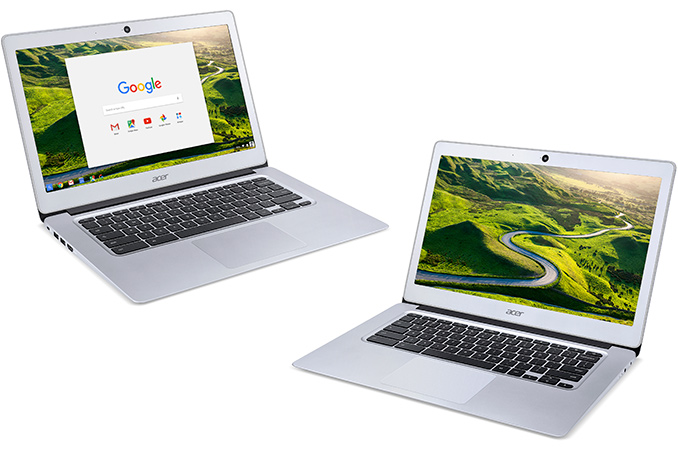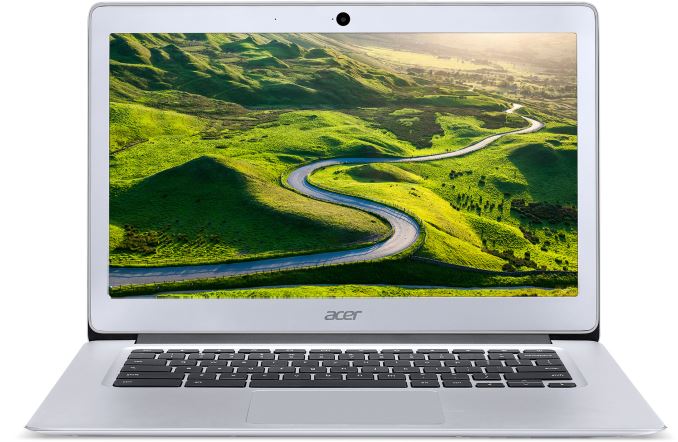Acer Unveils New Chromebook 14 with Up to 14-Hour Battery Life
by Anton Shilov on March 30, 2016 2:40 PM EST
Acer this week introduced its new family of Chromebooks that wed performance with portability. The new laptops feature multi-core x86 microprocessors, 14” displays as well as aluminum chassis. Even in its most advanced configuration, the Chromebook 14 costs only $299. Acer traditionally positions its Chromebooks as solutions for students as well as customers on a budget, who need basic computing and do not want to invest a lot.
Several years ago, personal computers running Google’s Chrome operating system were considered as cheap alternatives to Windows-based PCs, which is why they used affordable components and could not boast solid performance, despite the lightweight OS. Eventually, such PCs became relatively popular and manufacturers started to use more advanced ingredients, such as IPS displays or microprocessors with higher performance. Google itself introduced its Chromebook Pixel laptop in 2013 (and updated it in 2015), targeting premium buyers. The Chromebook Pixel is one the most advanced and powerful Chromebooks ever made thanks to its Core i7 “Broadwell” processor, a display with 3:2 aspect ratio as well as an aluminum body. Google’s Pixel demonstrated to other PC makers that it is possible to build premium Chrome OS-based notebooks and they followed with more advanced Chromebooks. The new Acer Chromebook 14 is not as powerful as the Pixel, but it is clearly a step into its direction with a high-resolution display as well as an all-aluminum chassis.
The Acer Chromebook 14 (CB3-431) features, as the name suggests, a 14” IPS display with 1920×1080 or 1366×768 resolution as well as 170-degree viewing angles and an anti-glare coating. Unlike the Chromebook Pixel, Acer’s new laptops have 16:9 aspect ratio with all of its advantages for video viewing and disadvantages for Internet surfing. The model with higher resolution can work on one battery charge for 12 hours, whereas the Chromebook 14 with 1366×768 resolution boasts with up to 14-hour battery life on a single charge.
The Chromebook 14 laptops are based on Intel Celeron “Braswell” processors with two (Celeron N3060) or four (Celeron N3160/N3150) cores featuring the Airmont micro-architecture and up to 1.60 GHz clock-rate, Intel’s Intel Gen 9 graphics core with 12 execution units as well as up to 6 W TDP. Unlike Google’s Chromebook Pixel as well as Acer’s Chromebook 15, the Chromebook 14 cannot integrate a high-performance CPU featuring Broadwell micro-architecture, but that was certainly a trade-off between the price and portability.
| Acer Chromebook 14 Specifications | |||
| Acer Chromebook 14 full HD | Acer Chromebook 14 HD | ||
| Screen Resolution | 1366×768 | 1920×1080 | |
| CPU | Dual-core Intel Celeron N3060 or Quad-core Intel Celeron N3150/3160 | ||
| Graphics | Intel HD Graphics 400/405 (Gen 8, 12 execution units) | ||
| RAM | 2 GB or 4 GB LPDDR3 | ||
| Storage | 16 GB or 32 GB of eMMC storage | ||
| Wi-Fi | 2x2 MIMO 802.11ac Wi-Fi module | ||
| Bluetooth | Bluetooth 4.2 | ||
| USB | 2 USB 3.0 ports | ||
| HDMI | One HDMI output | ||
| Other I/O | Microphone, stereo speakers, audio jack | ||
| Thickness | 17 mm / 0.66" | ||
| Weight | 1.55 kilograms / 3.42 pounds | ||
| Price | $299 for the launch model | ||
Acer equips its Chromebook 14 laptops with 2 GB or 4 GB of LPDDR3 RAM (which is a good news for battery life), 16 GB or 32 GB of eMMC solid-state storage as well as a dual-band 2x2 MIMO 802.11ac Wi-Fi module with Bluetooth 4.2. The systems also feature a 720p webcam, a 3.5-mm mini jack, a microphone, stereo speakers, two USB 3.0 ports as well as an HDMI output.
The Chromebook 14 from Acer is 17 mm thick and weighs 1.55 kilograms, which is in line with many portable laptops. Acer claims that its fanless cooling system is enough to cool-down Intel’s Celeron CPU with a 6 W TDP, which is why the Chromebook 14 has no fans at all.
Acer did not say much about the price of its Chromebook 14. The launch model will be available next month with a Full HD display, 32 GB storage and 4 GB RAM starting at $299.99 in the U.S. and $399.99 (CAD) in Canada. Other Chromebook 14 models will sport lower amount of storage and RAM as well as a lower-resolution screen, but also a longer battery life. Their prices are unknown, but will clearly be different in different countries.

















42 Comments
View All Comments
famfam - Wednesday, March 30, 2016 - link
My sister bought me a chromebook. Asus C100P.. Never would have went there myself. But, it's an amazing machine. I'm totally hooked. Such a lightweight OS, that battery lasts longer, and start up is amazingly fast. There are a mad amount of apps, which I can also access from any machine with Chrome. I'm sold! Can't be beat for 90% of my use!auerbach - Wednesday, March 30, 2016 - link
We have three Chromebooks in a household with four people. So "no sales" might be a slight exaggeration.mporter88 - Wednesday, March 30, 2016 - link
I run a chromebook and use it as the front end for two remote dual monitor towers. One in my garage and one at my office. Just a tremendous change to how I work and web. The dual monitor deal is that you just mouse over to the other monitor. There is no boundary between the displays. Just slick as hell. Key is to have your monitors match the screen of your chromebook. 1080P in my case as I bought the Chromebook 15.The Chrome Remote Desktop app is just rock solid. I can access the same two machines as easily from a hotel room in vegas as I can from my living room.
Great battery life. Solid build and form factor.
Cannot say enough good things about the Chromebook 15 and the ChromeOS.
the tool does it's job. What else is needed?
noelburke - Thursday, March 31, 2016 - link
Great examples of how to properly utilize Chromebook capabilities... I do the same for our data center remote access - and back to my home office laptop. I often kid associates - that I run Win7 on my Chromebook - and of course what I really mean is - I don't care to lug around a boat anchor with poor battery life - so if and when I DO need the full experience - I'll remote to it with my Chromebook (Toshiba 14") and not require rotator cuff surgery from hauling it around everywhere I go. Even my OpenVPN works well on Chrome OS. LOVE this thingBrokenCrayons - Thursday, March 31, 2016 - link
There are lots of inexpensive Windows devices that can compete with hardware specs, weight, and battery life. They also can compete on cost quite easily. In fact some of the recent premium Chromebooks are cost prohibitive compared to conventional laptops so I think it might be a bit of an exaggeration when a person argues that they'd have to carry around a boat anchor, suffer injuries, and get poor battery life with a Windows system.KeithR - Friday, April 1, 2016 - link
And not one of those "comparable" Win devices will get within a country mile of the performance of a CB, performing similar tasks.BrokenCrayons - Friday, April 1, 2016 - link
While certainly there are some people who would happily make purchase decisions based on "a country mile" of additional performance without any supporting evidence, may others may prefer more specific terminology. Is there a conversion formula you can share with the rest of the readers so we can calculate compute workload outcomes in different terms?JamesU - Saturday, April 2, 2016 - link
We get it Keith, you really love your Chromebook.eebrah - Tuesday, May 31, 2016 - link
I don't know .... Windows PCs with 1080p, 4GB of RAM and an Aluminium chasis for $300? Haven't come across any of those so far unless it is some sort of clearance salekaidenshi - Thursday, March 31, 2016 - link
It's actually a pretty good OS these days, and if you're not satisfied you can convert it to a full blown Linux distro with a few commands. Or you could go back to your more expensive, less refined Windows laptop with the perpetual alpha stage OS Microsoft expects you to test 24/7 for them.